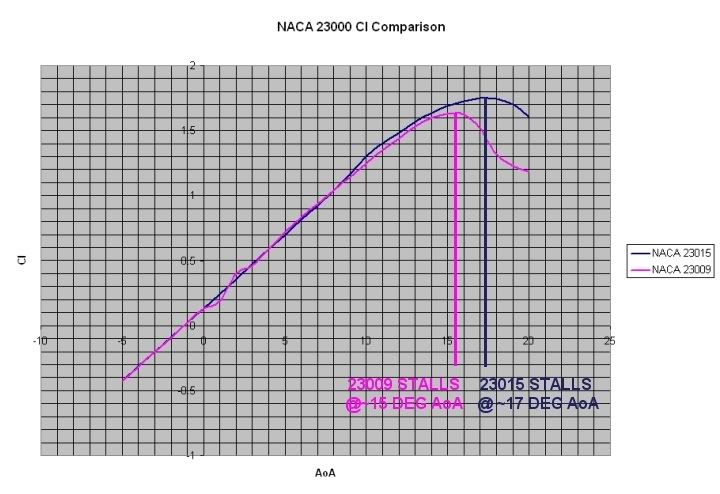Ok, here is an example of why a thinner wing may not be "better" than a thicker wing. I have to admit that this airfoil did not turn out to be as good an example as I thought it would. I'll look for a better one later...
I ran both the NACA 23015 and the NACA 23009 through XFOIL96. XFOIL is an airfoil analysis program. XFOIL is not in total agreement with the NACA airfoil wind tunnel test data shown in NACA Report 824, but the comparison is useful regardless. For my test runs, the Reynolds number was set at 3.0E6 (or 3,000,000) and the Mach at .17 which are the same conditions used by NACA to develop the data for Report 824. These are NOT similar to the conditions that an actual aircraft using this airfoil during WWII would have--I merely used them to set up the same conditions NACA used.

In this image, you'll notice that the thinner airfoil (NACA 23009) a 9% thickness airfoil, stalls earlier than the thicker airfoil (NACA 23015). Also note that beginning at about 9 degrees AoA, the 23015 produces more lift at the same AoA, all the way to the stall.

In this image, you'll notice that the thinner airfoil creates less drag at low AoA, but as the AoA increases, the difference between the two decreases, and by 12 degrees AoA, the thinner wing actually produces more drag at the same AoA than the thicker wing.
I didn't take the time to do a lift/drag curve for both aircraft, but you could see that at certain portions of the flight envelope, the thicker airfoil section can be more "aerodynamic" than the thinner airfoil section.
Another interesting illustration here is the impact of airfoil thickness on tip stalls. Almost all WWII fighter aircraft used thickness taper, where the airfoil thickness at the wing tip was thinner than at the root. The NACA 23012 root, 23009 tip was a popular combination on many WWII aircraft. You can see from this comparison, that as the wing approached the stall condition, the wing tip would stall much earlier than the root. When this happens, the engine torque rolls the aircraft quickly over onto its back, aka a snap roll.
I'll see if I can't follow up on this later...